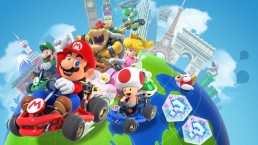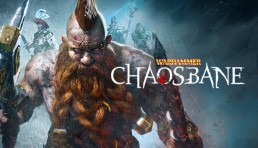Review | Death Stranding
Despite all the mystery beforehand, the concept behind Death Stranding is simple, you deliver packages from point A to B. The degree of detail that goes into this work and the excellent presentation make Death Stranding a very special experience.
It’s also an extremely personal experience. To what extent you enjoy Death Stranding depends on several factors. Are you going to be disappointed that Death Stranding is essentially a mailman simulator? Or are you open to a dazzling story in which Kojima combines all sorts of philosophies about life, death and heaven with the experiences and encounters he has experienced in his own life in recent years? And are you someone who, after a long hike, stands still on a hill, enjoys the view and perhaps even withdraws the usefulness of existence in a fraction of a moment?
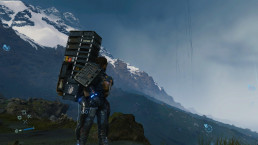
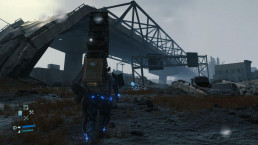

In the virtual skin of Sam Porter Bridges you visit at least more than enough hilltops. This courier lives in a post-apocalyptic version of the United States. The world is struggling with the consequences of a disaster that blurs the dividing line between the living and the dead. The result is that rain now brings ‘Timefall’. These showers not only age living things and materials at an exceptionally rapid pace, during the rain the souls of deceased people, called “BTs”, float around to draw you into their dimension.
As a result, humanity has become fragmented and different population groups live in isolation from each other, in cities surrounded by walls. As a courier, Sam not only has the task of transporting packages between these locations, he must also connect the locations via an online network on behalf of the US president. In this way the isolated societies can communicate with each other and exchange information.
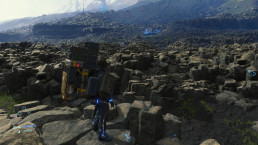
And so Sam loads all sorts of containers on his back, arms and legs and then transports them to the various places where people live. The satisfaction that you get from this activity is not just enjoying the beautiful environments that you walk through. The challenge that comes with balancing loads also provokes. The weight that Sam places on his body influences how agile he is. With a large load of containers on his back, the poor courier wobbles that it is a sweet delight and you have to use the shoulder buttons to stay in balance.
Unfortunately for him, most of the game world consists of rocks, mountains and rivers, which makes it even more difficult to move packages around on every part of the body. In a river, chances are that you will be pulled over by the current, while you need ladders and climbing ropes to make your way up or down in hilly areas. If you fall in love with you, then you have the chance that a number of containers will fall from your back.
Especially in the first half of the game you are relatively fragile and the environment is your biggest enemy. It is really a sport to work as efficiently as possible and to take the right amount of containers with you and to position them properly during your treks. This is reinforced by the fact that after each delivery you get a score and unlock upgrades that make you even better at work.
Keeping your balance is just one of many game play systems that the game has. Sam has to rest, supplement his stamina with Monster energy drinks, take a shower and occasionally take a pee. Packages on your body wear and rust, especially when you are in a Timefall mode, and with a special spray you give them a new protective layer. Vehicles run on energy and therefore need to be charged, shoes wear out and need replacing quickly. All these elements contribute to the experience and also ensure that your work as a package delivery person remains challenging.
In the meantime, Sam also carries a baby. This “BB” can observe the floating spirits in the air – the aforementioned BTs. When they appear, Death Stranding is at its most exciting. Thunder rolls through the air, after the first few drops it starts to clatter and the meter with which your baby indicates that there are BTs in the area starts to blink and beep. If you keep a close eye on this meter, it is possible to sneak past the almost invisible ghosts.
If you are close to such a BT, it is better to stand still and hold your breath while you hear the BT thumping around Sam. If the BT nevertheless knows how to grab you, the situation will escalate and you will have a boss fight. If you lose that fight, it will have far-reaching consequences for the game world. Trying not to be fooled by a BT is really scary and you can only hope for a happy ending at those moments. Later in the game you also get ways to start attacking BTs, with grenades and bullets that – well, why not? – are made from Sam’s body fluid. The game gives you the choice from that moment to sneak or take action.
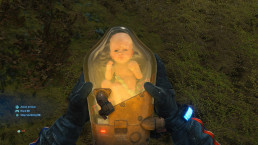
As if all these elements do not yet provide enough complexity, Death Stranding also contains an online component. Although you don’t see other players literally walking around in the game world, their actions are all the more important. With materials that you find in the game world, you can create all kinds of structures that facilitate moving around in the faded world of Death Stranding. A bridge over a river here, a paved road there, a charging station for your vehicle and stamina elsewhere. Once you have linked a location to the network, various structures of other players become visible. You can even add materials to creations from those players to upgrade a building. These structures also wear out over time thanks to the Timefall rain showers.
In line with this you can give likes to buildings and other placed objects. During the game you will not only receive likes from the characters in the game, but also from other players who, for example, drive along your roads, sleep in your self-built safe house or appreciate your presence in their game in any way. It’s not entirely clear whether Kojima mainly criticizes the current social media culture, or praises it. In any case, it is a genius social experiment to let players partly determine the structure of the game world. Do they install charging stations at the desired places in your game, or are you reliant on yourself because of the laziness of others?
It is a bizarre concept, players who have to connect the US as a postman, but Kojima knows how to turn it into a cinematic whole that is difficult to compare with other games. When you carefully descend from a mountain to a few industrial buildings, the camera automatically zooms out and a desolate song from the Icelandic band Low Roar is deployed at exactly the right time, everything comes together. Death Stranding knows how to get deep at these moments. Sam’s journey is also depicted in a spectacular way. Especially on a PlayStation 4 Pro with a TV that supports HDR, your mouth regularly falls open when you see the extremely detailed faces of characters, beautiful nature and decaying infrastructure.
Score:
9,0
– This is not a game for everybody.
– The story is sometimes a bit vague.
+ A very stunning and beautifull designed game world.
+ Unique combination of gameplay elements.
+ Amazing acting with a lot of emotion.
Death Stranding is exclusively available on PlayStation 4 November 8. For this review, the game was played on a PlayStation 4 Pro.
Review | The Outer Worlds
Even after the big disappointment called Fallout 76, Bethesda does not seem to be willing to make a new single player game in the franchise. Fortunately, New Vegas developer Obsidian is and they are coming with The Outer Worlds.
This game knows how to merge shooters and RPGs. You’ll have the choice to tackle situations in multiple ways, so that you can get through the game shooting, hacking or bluffing.
This spiritual successor takes place in space in a colony that spans several planets, but this sci-fi setting is also full of the 1950s references. Radios play old-fashioned music in villages with the same old-fashioned neon lighting. And those villages try to shape their own society in a crazy way.

In The Outer Worlds you play a settler who was frozen years ago so that he could travel to a far-away galaxy on a spaceship. However, due to complications, your ship was pushed off course and you never arrived. When a mysterious scientist brings you to life, he sends you on an adventure to get the space colony back on the right path and reduce the grip of mega companies.
You can fully determine how you do that. At the start of the game you put together your own character with specializations, which you can do more and more as you grow in level. For example, you can choose to shoot through the game, try to sneak, or hack hackers to do the heavy work for you. Invest enough in your speaking skills and you can lie, intimidate and seduce to ensure that everything works out well.
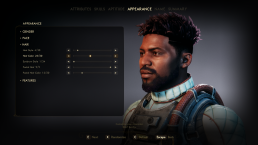
Those choices are not new in role-playing, but there are few games that give you as much freedom as The Outer Worlds. Almost every mission in the game has several ways you can complete it, where you can also choose from multiple endings with different results. For example, do you choose to return a stolen blueprint of an experimental weapon to the designer?
The impact of your choices feels concrete. For example, if you sell the above weapon, it creates prestige at a local Mafioso – which in turn helps you with a completely different mission. You never have to choose, which extraterrestrial race will save you from ruin, but the smaller effects make the universe feel alive. Every NPC sees what you do and takes that into account during dialogues. Dialogues which are all very well voice acted and story telling.
This can even be seen in the smallest dialogues. If you shoot a bandit at the start of the game and steal his clothes because the stats are simply better, villagers feel uncomfortable when you talk to them. After all, you are dressed like the same person who has been terrorizing their friends and family for years. You are immediately faced with a choice: do you abuse that fear to get your way, or do you reassure the villagers?
And such examples are numerous in The Outer Worlds. Both in the main storyline and in the many side missions. It gives the impression that you are really influencing the world and not simply walking the path made by the gamemaker.
All of this is supported by strong writing. Although the world of The Outer Worlds is clearly inspired by Fallout, the game tackles a number of themes that are responded to perfectly. Just like in many science fiction, the galaxy is ruled by mega corporations, but in The Outer Worlds that is food for satire.
Personnel employed by Spacer’s Choice, for example, are obliged to end every conversation with a company slogan, regardless of the situation. In addition, their contracts are full of clauses that make life difficult for them. Wages are deducted preventively to pay for the future graves of staff, or to cover the costs of a suicide. According to the company, a suicide is nothing less than “damaging company property”.
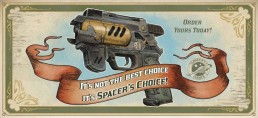

Although this is strictly a role play, you primarily fight by shooting the old-fashioned way. For the most part, that works great: you aim your weapons and shoot, just like in any modern shooter. Even with heavier weapons a sense of impact is missing.
You can also delay time with the press of a shoulder button. If you stand still it can be done for a long time, but as soon as you move or shoot, a meter starts running. If that meter is empty, you have to wait until you can do this again. At the start of the game you are barely allowed to use it, but as you level and invest in new skills you can extend its use and return it more often.
Fighting certainly feels a bit frustrating at the start of the game. One enemy can attack you dozens of times without having a major impact, while the other can hit you in two shots. That while the game does not clearly show the difference in power between the two. It forces you to be careful, but I regularly felt that I was reaching my end unfairly.
As soon as you reach a higher level, fights become more interesting. You get access to new skills that, in the long run, compliment your carefully chosen weapon arsenal. However, the shooting area never feels impressive enough to support the rest of the game.
I can happily forgive The Outer Worlds. The value of this game is not because of the crashing of opponents, but in the gigantic freedom of choice that you have. In the fact that you can shoot down a wanted criminal, but you can also make a pact with him to take back the police. This is a game that always surprises you with unexpected possibilities.
Score:
9,0
– Often long loading times
– Weapons lack impact
+ Visualy stunning worlds
+ Creative writing
+ A lot of freedom
Review | Mario Kart Tour a greedy kart game on the go
The news that Mario Kart Tour broke all download records during the first few days after release are not surprising to anyone who has ever played a Mario Kart game. The racing franchise with Nintendo’s mascot behind the wheel has a kind of universal appeal that most mobile games can only dream of.
Mario Kart Tour is not just another mobile game. It is a free version of one of Nintendo’s most popular series ever. The game also makes a good first impression after a little awkward tampering with the touch controls. It all looks neatly finished and doesn’t just consist of recycled racers and tracks. Diddy Kong, who strangely lacked in Mario Kart 8, and newcomer Pauline are participating this time. There are also quite a few new parts that get inspiration from, among other things, Super Mario Odyssey. In addition, there is a huge selection of vehicles and parts that provide the necessary variation.
Although it seems like there are many options, thats a bit disappointing while racing. Obviously it’s all made a lot simpler.
Falling off the track is not possible and the races themselves are nowhere as chaotic and unpredictable as you might be used to from other Mario Kart games.
The driving itself feels somewhat unnatural in the beginning, because it has to be steared against the right direction. You’ll eventualy get used to that, but it never gets as good as drifting with a controller. Mario Kart Tour therefore comes across as a less tight-playing collection of what the last few Mario Karts managed to make so much fun for everyone.
Mario Kart Tour really shows its true face after the first four races. Quite typical of this type of free mobile games there are several types of currencies that each provide access to specific parts of the game. With the few coins on the track during the races, new characters, karts and kites can be purchased. They are a bit on the expensive side, so you cannot rob the whole store after having driven one whole cup and finishing in first place.
That is because gems are involved, providing access to a special race in which the entire track is covered with coins. However, the same gems can also be used for the loot boxes, or rather, loot tubes that contain unique and exclusive content. The chance that you actually unlock your favorite character in this way is very small. If you want to race Mario yourself, you really have to be patient, because the first few cups will be loaded with the characters below the rankings. To race quickly with the best characters, money must be spend or a considerable amount of time needs to be invested in the game.
Mario Kart Tour does not seem bother with it. The menus of the game are full of reminders to quickly buy extra gems and a special monthly subscription is even recommended. For the meager price of 5.49 euros per month you get all kinds of bonuses with the Gold Pass, such as the 200cc mode. That offer feels extra stingy because of the slightly earlier launched Apple Arcade. For a few euro cents less you have quality games that do not constantly ask for money.



In addition, the fact that Mario Kart Tour does not always communicate clearly about the situation. The illusion is created that you are racing against other players, but in reality it are bots with the usernames of other drivers. It is nevertheless necessary to have an online connection, otherwise the race cannot be started at all. Real online races against other players are added later.
Because of this setup it is not surprising if you long for the simpler times of Mario Kart 8 Deluxe. This is therefore not a substitute for what from now on should be called the real Mario Kart. Tour especially cleverly anticipates your collection. The prospect of unlocking every part and every racer depends entirely on draining your wallet, but there’s a good chance that I will keep returning with millions of others. The attraction of Mario Kart is even in its diluted form too large to resist.
Mario Kart Tour is now available for iOS and Android.
Score:
5,0
– A bit on the simple side
– Feels extremely greedy
+ Exclusive new trail
+ Looks great
Review | Gears 5 is one of the best Xbox One exclusives.
After the release of Gears of War: Judgment in 2013, it seemed that the Gears series was on its way to its retirement. Judgment was a great game, but did not reach the heights of the original trilogy. After the unveiling of Gears of War 4, the question arose whether there was still room in the current shooter genre for the once influential third-person shooter. Whereas The Coalition with Gears of War 4 was especially safe in the footsteps of Epic Games, it is now taking big leaps forward with Gears 5.
Obviously, taking on a much-loved franchise and introducing new characters, stories and gameplay elements is a tough and risky task, while the old school fans still covers the bulk of the community. For example, many thought the new protagonists from Gears of War 4 could not match the old Delta Squad. Gears 5, however, shows that Kait, Del and JD are indeed worthy successors to the heroes from the original trilogy. This time, the game does not have to have a set of new weapons and enemies, but rather a story that holds us in its tight grip from start to finish.
This is mainly due to the main characters who come into their own in Gears 5 much better than in part four. The driving force behind this story is Kait, who made a shocking discovery at the end of the previous part, causing her to be confused in Gears 5. Even before we get to work with the heroine, we step into the skin of JD Fenix, who still has a respectful admiration for his dad, Marcus. JD is all too aware of the fact that his father has meant a lot to mankind and that leaves him constantly trying to prove himself on the battlefield, much to Marcus’s annoyance. This heroic attitude leads to a catastrophic event, which unfortunately results in difficulties within Delta Squad.
This event leads us to the moment when we finally get Kait under our control. That is also the moment when Gears 5 for the first time breaks with the linear gameplay we all know and places us in atmospheric open-world areas in which we can look for missions ourselves. So we no longer have static battles to be allowed to proceed to the next checkpoint, but cross beautiful environments such as the snowy area around Mount Kadar and a desert-like area in the UIR on our skiff, a kind of sled-type vehicle. These small open worlds are limited to the two middle acts. Apart from a handful of main missions and optional side missions where you earn upgrades for veteran Jack, there is not much to do in these areas, but Gears 5’s experience of traveling from mission to mission graces itself primarily due to the interaction between the different characters during these treks are deepened.
So now it is mainly in those conversations between main characters, which gives the story a certain impact more than ever before in the series. For example, Kait and Del reflect on the history that is (not) told by the COG, their friendship with JD and whether they are on the right path themselves. They also try to put recent events in perspective. One of these recent events is the increased intelligence of The Swarm. This is not only referred to as a narrative, but also during the firefights we see that The Swarm has become much more agile, looks up confrontation and makes it increasingly difficult for the player to hide behind a crumbling wall. In short, artificial intelligence has noticeably improved since part four and requires more tactical insight than before, which greatly benefits the gameplay.

You’ll get those tactical possibilities in the form of Jack, because the gunfights becomes a lot more dynamic thanks to a number of clever adjustments to our mechanical handler. For example, Jack can now scan the area to spot enemies, regularly attack enemies, pick up command weapons and ammunition, or temporarily generate an energy shield for the player to ward off bullets. It is these types of small adjustments that, for the first time in years, give a fresh feel to the franchise.
Especially in the first and the last act there are certain scenes that will blow you over in terms of intense fighting. Gears 5 starts to go full throttle early in the game and won’t let you go until the abrupt end. Without giving away too much about the story, it seemed as if defeating the final boss was just the beginning of another act. Although the single player of Gears 5 is considerably longer than that of Gears 4, it still feels like the story is ending too quickly. However, it does not mean that I still enjoyed it immensely.
The fact that the single player campaign is so impressive does not mean that the multiplayer is subordinate to this. The multiplayer is again very strong and has largely remained unchanged. The launch of the game unfortunately brought some server problems, but in the days that followed I hardly noticed anything. Versus again consists of an arcade mode in which two teams of five compete against each other in different game modes. New to this mode is the ability to earn points during game play to unlock weapons. An important difference with the ranked mode is that the Gnasher shotgun has been removed. In addition, you playfully unlock certain skills, such as the ability to run a little faster or extra health. This makes it easier for newcomers in particular to master the game before competing against each other in Ranked mode.

The latest showpiece of the multiplayer is the Escape mode, in which a team of three players has to free themselves from a base occupied by the Swarm, which is slowly filling up with poisoned gas. The feeling that you are being chased by this gas ensures that the tension during a game of Escape is good and nerve wrecking. It’s therefore important to quickly as possible make short work with increasingly challenging waves of enemies, while ammunition is scarce. Escape excels especially at higher levels of difficulty. Because ammunition is scarce, it is important to be careful with this and stay close to your teammates. The trick in Escape is mainly to eliminate targeted enemies together before you move forward. However, it is advisable to play this mode with a solid party, since players often tend to leave the game as it gets harder.
Everything indicates that The Coalition dares to leave its permanent mark on the series. Where Gears of War 4 remained as close as possible to the essence of the series, the developer in Gears 5 implements the necessary innovations that makes Gears interesting for both fans and newcomers. The iconic gameplay has remained intact, but is now extra layered thanks to the tactical possibilities that Jack brings. In combination with the strong story, this sometimes results in memorable moments that I haven’t experienced in a Gears title since the original trilogy. Add that to the sublime multiplayer and you’ll think of Gears 5 one of the best Xbox One exclusives of recent years.
Score:
9,0
– Server problems during launch.
– Just a few side missions.
– Very abrupt ending.
+ Characters have more depth
+ Compelling story
+ Dynamic firefights that put you on the edge of your seat
+ Extensive multiplayer modes
Review | Borderlands 3
Looting and shooting has never been this great!
As progressive as Borderlands 2 was, the sequel is that traditional. At a time when, thanks to titles such as The Division, the lootshooter consists of open online worlds with a constant stream of content, Borderlands 3 remains close to the roots of the franchise. And that is absolutely fine, because the game is a fantastic cooperative loot shooter and a wonderful parody on the stream culture.
Borderlands 3 is a tour through the rest of the universe, which has been hinted at numerous times in previous games. The Calypso twins, two evil streamers with crazy followers, force Lilith, the player and a lot of old acquaintances to scour the universe for The Great Vault: the ultimate power. For those who appreciate puberty humor and were looking for a fresh setting, this is the premise for a hilarious roller coaster ride!
Leaving Pandora, which has already been chewed out, is a pleasant release, as we see when we visit the colorful new planets. Promethea is a brightly lit, futuristic city, Athenas has calming Eastern settlements and Eden-6 is a green, dangerous swamp planet. During the story, Borderlands throws 3 players between different conflicts that give each environment its own identity. On Promethea, for example, a childish war is raging between armament manufacturers Atlas and Maliwan and your Vault Hunter is embroiled in a cowboy-like blood feud within the Jakobs family.
The design of planets is grand, although loading individual areas sometimes breaks the pace of the game. It simply feels a bit old-fashioned to have to load another world instead of just chugging on with one of the vehicles. The rigid steering of vehicles is otherwise unchanged, although this is compensated by the fast Cyclone engine and above all a greatly improved fast travel system.
The downside of this traditional setup is that players have no idea of the scale of the planets, so the game often misleads you. Several times the story takes you back to a previously visited planet, where suddenly a new, large region opens up. Environments are richly filled with vegetation and all sorts of activities, so it is not striking that there are actually very few NPCs in the game world. Moreover, most of the action takes place in varied, well-designed environments.
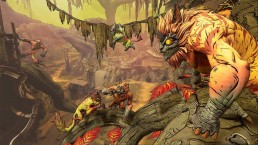
Side activities consist of crew missions, such as finding parts for a friend for Claptrap, and a considerable amount of side missions. Some contain a fun environment puzzle, but in general they must have the fantastic Borderlands humor, of which you already know if you can appreciate it. As usual, some of the best moments of the game can be found in these side missions. Think of a lurid brain transplant, setting up a network for an old pro-gamer, a shooting for the coffee supply in Promethea and even sad glimpses in the lives of characters. Ice-T, who plays the AI-driven teddy bear Balex, also deserves a compliment for his comic acting performance.
Nothing in Borderlands 3 is really serious and everywhere you’ll find comic details and references to the current internet culture. This manifests itself especially in the bad guys, Troy and Tyreen Calypso, who are actually a parody of the sometimes foolish supporters of Twitch streamers. Donations, loot boxes: it is all covered, and in my opinion largely successful. Fortunately, the background of the twins is also well deepened by their constant presence during main and side missions and they’re not only present for a smile.
Ninety percent of the gameplay consists of endless popping on screaming bullet sponges, which thanks to a greatly relaxed feeling of shooting remains fascinating for much longer than before. At 60fps (note: on the original PlayStation 4 and Xbox One consoles, the game runs on 30fps), the game even feels a bit like Apex Legends. Moving is faster, your Vault Hunter can now finally vault and sliding brings a pleasant flow to the gameplay. It feels like we can run, shoot, reload and switch weapons forever in circles.
Playing with the weapons themselves is also more fascinating thanks to a very broad randomly generated range. During your playing session you will find clearly several archetypes, but emotionally there is much more room for maneuver than in Borderlands 2. Some weapons are wonderfully exaggerated and each manufacturer brings unique bonuses, such as extra shields, reflective bullets in the event of a critical hit, infinite ammunition and shooting guns on legs. Even after about forty hours of playing, we still find plenty of new guns and with that, hunting for loot remains extremely fascinating after the story.
Weapons, as before, have elements, which means that despite aggressive opponents, players still have to think about which bullets they use. Vault Hunters also offer a deeper strategic layer thanks to the extensive skill tree. Players can now expand and mix three categories to your liking, resulting in a variety of options. For example, Fl4k can focus on a solo playing session, where his animals can revive him, or on pure damage with critical hits. The choice of a Vault Hunter – Zane, Amara, Fl4k or Moze – is therefore more difficult, and that is a nice luxury problem.
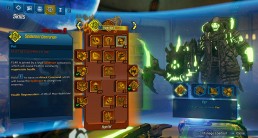
The way in which players can set up their skills also depends on whether they regularly play solo or with others. Borderlands 3 is an excellent experience on your own, but traditionally it remains superior while playing in co-op. In many ways, the game has evolved into the ultimate cooperative experience thanks to the ease with which players can enter each other’s sessions.
Moreover, loot scaling ensures that every player hits enemies and loot of his or her own level. That means that players can now play with everyone regardless of their progress. Borderlands 3 has more options that improve the quality of life. For example, it is possible to skip missions you have played with others in your own game, there is a machine that collects abandoned loot, weapons can be shared between your different characters, and it is even possible to mail weapons to each other.
And you’ll need that, because the endgame content of Borderlands 3 is quite extensive. There are Horde-like challenges in the form of Proving Grounds and Circle of Slaughter. There are also higher levels of difficulty that yield extra rare shoots after the story has been played. Add up the upcoming events and paid dlc, and I expect that i’ll continue to play Borderlands 3 for a long time.
Score:
9,0
– Loading of the maps sometimes breaks the pace of the game.
+ Planets are very varied.
+ Shooting feels good, smooth.
+ Profound skill trees.
+ Great cooperative options and gameplay.
Review | Warhammer: Chaosbane
Review | Warhammer: Chaosbane
Descend into dungeons, defeat monsters, collect loot. Yes, we have seen this before. But now it all takes place in the great Warhammer universe.
In Warhammer: Chaosbane you follow a story like many others: the world is once again threatened by chaos creatures and it needs you to save it. Nothing is more fun than hacking through hordes of enemies with skills that constantly grow in strength. Warhammer: Chaosbane knows how to evoke that feeling. Each of the four characters feels good to control and has skills that can be used in various tactical ways. Eko Software immediately wants to make it clear that the role-playing side of the game is important. You choose from the Empire Soldier, High Elf Mage, Dwarf Slayer and Wood elf Scout classes.
The first thing you notice is that your character cannot move during his or her attacks. There is also no specific action to dodge attacks. Instead, plant your feet on the ground and fire your skills at the enemies.
This may sound drowsy, but luckily it is not so bad when you unlock more skills. You receive skill points per level with which you can buy skills. The basic set is automatically unlocked, but you can gradually invest points to upgrade skills. And fortunately, those skills play very well. The Slayer has a fair amount of cool tricks in store, with some attacks costing rage points, while others feed his rage. This prevents you from constantly pressing the same button. More important are the cooldown times on special attacks, which you can only fire once in a while.
Then there’s the loot that you gradually collect. It is the standard procedure of picking up what enemies are dropping in the hope that it will yield better stats for your character. There is a shared treasure chest, so you can share your loot with other characters, you can sell them, craft them, and so on. What especially should make Chaosbane fun is the ability to play with others. There is a drop-in system where friends or strangers can accompany you in the search for better loot.
If you still want more after the story, you can dive into Expeditions, Boss Rushes and Treasure Maps. The first and the last of these, place you in a randomly generated area to perform a certain mission, often with custom elements to increase the challenge. The Boss Rushes appealed to me the most, and need you to kill a certain boss again, but this time the boss will be stronger so it also drop better loot.
My first impression of Warhammer: Chaosbane is very positive. It is very easy to get into a flow of fighting, collecting and exploring. The Warhammer license mainly feels like a new package and does not change the experience.
Score:
8,0
– Interface may be too small at several occasions
– Not enough interaction with the environment
+ Good voice acting
+ Visual stunning environments
+ Addictive gameplay
+ More than enough content
Review | A Plague Tale: Innocence
Dark, grim, and especially daring, that's how I would describe A Plague Tale. The French developer Asobo Studio has been working in the industry for years, but mainly has small-scale Disney licensing games on the resume when it decides to make a name for itself. This very ambitious game is the symbolic baptism of fire for the developer and the talented people at Asobo have survived without getting burned. The result is a game that once again underlines the power of story-driven single player games.
No knights in shiny armor or magicians in lavish robes adorn the cover of this game. In A Plague Tale: Innocence you control fifteen-year-old Amicia at the time of the Middle Ages, when the Black Death seized itself in France and left millions of victims behind. The corpses are piling up and the survivors are looking for a sin block. They find that in five-year-old Hugo, Amicia’s brother. Hugo has been suffering from a mysterious illness since his birth and lives separately from his sister, until the Inquisition comes knocking on and he barely escapes with Amicia.
Amicia and Hugo, luridly robbed of their peaceful lives as little Lady and Lord of the De Rune family, suddenly find themselves alone in a world torn apart by war and illness. With Hugo by her side, Amicia has to stay out of the hands of the Inquisition and other evil-minded parties by sneaking around unseen and leading soldiers around. You do that for example by throwing stones with her slingshot, but later you also learn all kinds of alchemy recipes that lead to more creative solutions.



These creative solutions often go hand in hand with a different kind of evil that only shows its razor sharp teeth when it gets dark. The Black Death gets its own face in this game, or rather, thousands of faces. We are of course talking about the rat plague. They throw themselves over fields like a tsunami and crawl out of holes in walls like a jet-black waterfall. With literally hundreds at a time, they crawl across your screen, which is just as impressive as it is disturbing. The only thing they shun is light; everything in the shade is eaten to the bone.
Initially the rats are an extra obstacle for Amicia and Hugo and you have to find a safe way through darkness through torches, but gradually you also learn to manipulate light sources and you can even use the rats to your advantage. For example, smash the lantern of an unsuspecting soldier and watch him be devoured alive while you sneak past Hugo. It is a tough world in which you must be willing to sacrifice everything in order to survive. It is clear that Amicia is not that innocent.
One thing is clear, no matter how tough she is, Amicia is not a fighter and she will not win a direct confrontation with a halberd-wielding soldier. The entire game, which roughly takes p fifteen hours, you are therefore mainly concerned with stealth, interspersed with simple puzzles and exploring the beautiful nature at your leisure during quiet moments. There is a fine balance between those three elements and thanks to the division into chapters, you can clearly feel how long you have left when the snapping, puzzling or exploring starts to get boring. Moreover, the redemption always seems to come at exactly the right time and the chapters never feel too long or too short. It is a small detail, but that makes playing A Plague Tale feel like reading a good book.
Although it is difficult to lay down the controller, there is also plenty to notice about the story. Amicia and Hugo are credible characters, but in the beginning the story pinches itself in weird turns to push the plot in a certain direction. For example, Hugo is a smart, well-balanced boy for his age, which means that an unhappy timed outburst of anger comes out of the blue. And although Amicia and Hugo and their later allies look very human and undergo character development, the villains remain one-dimensional until the end. There had been more to it.
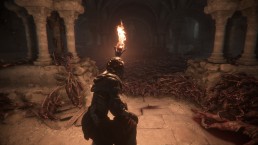


The power of the story of A Plague Tale is therefore in the small things. The whispered conversations between our heroes as you sneak through a hostile camp, Amicia’s increasingly louder heartbeat as a soldier approaches her hiding place; the spontaneous violin swings that scare you when sparkling red eyes emerge from the darkness, everything contributes to creating an immersive experience.
The graphic beauty of this game also plays an important role in this. Thanks to a soft, diffuse light, the enchanting landscapes, castles, cathedrals and villages that you pass get an almost supernatural look. You would almost forget that under that beauty there is often death and destruction. Contrasting with the beautiful nature you will find rotting carcasses, teeming rats and rivers of blood. In A Plague Tale, beauty is treacherous. It is a horribly beautiful, beautifully horrible game.
Fortunately, these environments are not only for walking from point A to point B, but you are also encouraged to explore the levels well. In every chapter, all kinds of collectibles are hidden, such as flowers and objects that give more context to the time in which the game takes place. Consider the scourges of flagellants or a rosary. The game cleverly responds to the secluded upbringing of Hugo, which makes him ignorant and curious about everyday things. Amicia is fortunate to explain to Hugo about these objects, and by extension the player.
A less well elaborated element is the crafting system for making alchemy brews and upgrades for your equipment. Anyone who has played a survival or open world game lately can imagine this, but the concept does not fit well with this game. This way you can make the decision to sacrifice many valuable materials for a strong remedy that can save you from a painful death, but due to the many checkpoints you can better invest those materials in a good upgrade of your slingshot. In addition, the game always ensures that a neat stack of materials is ready to solve the next puzzle, so there is no reason to use alchemy sparingly. The absence of a heavier degree of difficulty to make the materials more scarce and thereby offer additional challenges, therefore feels like a loss.
That does not mean that A Plague Tale: Innocence has become a beautiful game that continues to fascinate you from start to finish and is wonderfully consistent. Nothing about the game is really weak, but all elements reinforce each other and make the whole experience exactly that, an experience. It is an incredible debut for Asobo Studio and a win for the single player genre.
Score:
9,0
+ Exciting ambiance thanks to atmospheric graphics and sound.
+ Varied and refreshing gameplay
+ Compelling story
– Occasionally falls into clichés
Review |
Score:
0,0
–
–
+
+
+
+
Review | Days Gone
Days Gone is a safe game and a beautiful freak show in an unsafe game world.
Tough and Badass looking biker Deacon is facing a crossroads: during a zombie outbreak – this time they are called “freakers” – he can go with a helicopter that is about to leave for a safe camp. However, there is only room for two people, and Deacon is just now on the road with his injured wife Sarah and his mate Boozer. He decides to put his wife on the helicopter – after all, she can use the aid best – and to accompany Boozer to increase his chances of survival.
Days Gone then gives you control over Deacon a few years after the incident. The helicopter with Sarah on board crashed shortly after departure and Deacon never fully processed the loss. Meanwhile, he and Boozer, and with them all remaining people, have built a new life in a United States flooded with freakers.
The close friends spend the night safely in a tower surrounded by fencing and in the meantime do some jobs and maintenance around the various camps with survivors erected around them. Boozer and Deacon begin to play on their free biker existence, but there is no room for departure: due to some unfortunate situations, they desperately need the help of the people in the camps.
In Days Gone you solve all kinds of tasks for prominent figures from in and around the various camps. You do all this in the state of Oregon, an open game world that has been designed with a lot of variation and detail. You really have the feeling that you’re walking or driving through a corrupt part of America, where the test of time makes the various buildings crumble and nature has taken over large areas. The story guides you through the various camps and lets you explore the different areas step by step, from forests and swampy marshes to sandy plains. It is a true pleasure to explore the game world with your motorcycle, your trusty Steel steed on and off road.
Or, well, pleasure, the tension can be clingy regularly, since the world is flooded with freakers. You can easily handle one such human-eating monster with a careful sneak attack or by hacking into it. They respond to sight and sound, so sneaking around is advisable, but they are not really smart. However, a large group of freakers can hide behind every corner. These so-called “hordes” sometimes consist of hundreds of zombies and can arise at any time, including during missions. It is impossible to eliminate these hurdles on your own and the strategy that you had to complete a mission must be heavily adjusted at that time. It often pays to just choose to get away safely, to return at a different time.
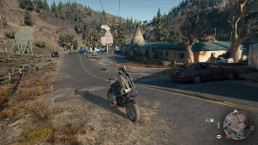
A highlight of Days Gone is the aforementioned motorcycle. The bike will quickly feel like your child. It can be broken and must then be made, or soon runs out of fuel. Then it is important to refuel on time at an abandoned gas station or in a camp, or to spot an abandoned jerry can along the way. This is really important: if your motorcycle stops running, it is damned hard to flee from large groups of freakers or aggressive gangs and wild animals, and the game world is far too large to cross on foot. Your motorcycle always stays where you left it, so make sure you find it easily when you wander off.
The survival element is also slightly extended throughout the rest of the game. Ammunition, especially at the start of the game, is scarce and the game motivates you to make melee weapons, Molotov cocktails and medkits with all sorts of things that you find along the way. Days Gone does not put as much emphasis on realism as other survival games but finds a fine balance between realism and play-friendliness in this. The scarcity of items and ammunition and the preciousness of your bike, combined with the hostile game world, ensure that you will never really feel at ease outside of a safe camp. Exactly as it should be!
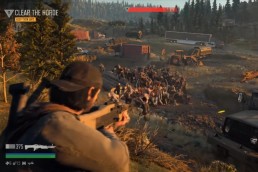
Apart from some annoying random events, like after being snipped off of your bike by a sniper ten times or once again being captured by a group of bandits, the main part of the game consists of the narrative missions. These missions are dressed up with hours of cut-scenes full of excellent acting. The different camps are filled with colorful characters that often appear cool and selfish, a requirement for survival in this world. But every now and then a trickle of humanity trickles through, giving these emotional moments all the more impact.
The way in which Deacon slowly but surely learns more about the behavior of large groups of freakers knows how to fascinate. His friendship with Boozer and the mourning of his wife make the main character feel like a man of flesh and blood. The emotional highlights of a The Last of Us are not reached, but some scenes are cautiously approaching.
However, the story cannot hide the monotony of the missions themselves. After a few hours you will notice that you are doing the same things in Days Gone. Drive from A to B, destroy the freaker nests in an area, rescue an abducted camp resident, or follow a government research team in old-fashioned mandatory stealth sections. The story covers tens of hours and it would have benefited the game if the quantity had been reduced and more focus had been placed on the quality of the individual missions.
Also the perfect finish that we are used to from the big PlayStation 4 exclusives is missing here. In spite of excellent graphics and controls, bugs pop up every now and then. I had to restart some missions because the game made it impossible to move forward. The engine also got stuck a few times in the area and the frame rate dived down through specific areas for short moments. Bend Studio has since released a patch and is working on a second one, but it was not available during the lion’s share of our playing experience. It remains to be seen whether the patches do this
Score:
8,0
– Gameplay during missions is repetitive.
– Some annoying bugs, causing you to restart the game or missions.
+ Survival on your motorcycle works.
+ Voice acting and story are top quality.
+ Fascinating and beautifull open world.
Review | Anthem
While the reviews in progress, I waited for the day one patch for the final conclusion.
Anthem tells a very and broad story that master storyteller BioWare knows how to handle and tell. At least, you would expect that. Unfortunately, the story remains safe on the surface. Just like the gameplay, the characters and the amount of content. Anthem is not a bad game, but certainly not a good one either. Does this mean that you cannot enjoy it? Certainly not! But those looking for the complete looter-shooter experience must have a lot of patience or play a different game.
Rarely did a game give a more paradoxical feeling of freedom than Anthem. Your Javelin, your personal Iron-Man suit, lets you experience a wonderful feeling of freedom with minimal effort. At the push of a button you ascend and fly just over the treetops of the truly beautiful world that BioWare has created. You avoid enemy fire with a barrel roll and while floating, you approach special enemies while using your skills. Shooting at the pretty silly and suicidal enemies is wonderful. You fire or freeze a group of enemies, and then you throw a bomb on it for a huge damage bonus.
But just when you think you are one with the world of Anthem, when you think you are an iron killing machine, the game will blow you back. You can’t stay too long, you have to keep going. And if you don’t fly to the next point fast enough, you can expect a loading screen, even though this loading interrupts part of the story you’re trying to follow.



It is symptomatic for the whole of Anthem. The game has no continuity, no immersion. Anthem does not want you to do a whole lot in one go, but to break everything into pieces that are behind a loading screen. Take as an example the equipment and weapons to be found: this is hidden in a kind of box that only when you stop your playing session shows what is in it. Stopping playing is rewarded in a certain sense, which is a bizarre and unfortunate design choice.
You always have to return to the Forge, the place where you can customize your Javelin with your finds and change the looks. There’s nothing wrong with the Forge itself: it’s a handy screen in which you quickly switch between your weapons and equipment in the form of icons. In an instant you have changed your Javelin in terms of color and cosmetic parts. You can buy cosmetic parts with real money, but also for a reasonable sum of the ingame currency. The problem of the Forge is that this part is behind a loading screen and cannot be accessed while playing. Adjusting your weapons or equipment to a situation that you had not anticipated is not possible while playing. The result is that you sometimes feel Javelin useless, while you have the right equipment in your possession.

Fortunately there are still the challenges. These challenges, ranging from killing a certain number of monsters with only a specific weapon to completing a certain amount of events, do not offer really exciting rewards, but they do give you a lot to do. There are also daily, weekly and monthly goals to complete.
You can only start the endgame yourself when you are level 30, and then it is about content that you already know, but that can then be played at a higher level of difficulty. Anthem then scatters with a good loot and that is of course great, but it also ensures that players of level 30 have quickly brought in the best loot so that there is really little left to do, apart from the challenges.
Anthem’s biggest problem, however, is that it was developed by BioWare. You can expect more from BioWare than what Anthem is at the moment. That is not entirely fair. Because when you look objectively at the game itself, it is scanty, but certainly playable. If you are only looking for simple fun shooting in a beautiful world while you fly through the air like a bird, Anthem may be something for you, because the game is really excellent. But this will be the minority. Everyone who likes to play BioWare games expects more from the story and the world. This developer invariably offers the highlights of his games there.
In addition, Anthem is not really what it promises to be. Anyone who likes to play looter shooters will notice that Anthem is actually not with the strange loot system. Anyone who likes to play co-op in a close team can do this in Anthem, but then via a Discord server, because the game itself offers a kind of pseudo team game without functional means of communication. But even the people who only come for flying and shooting will be bothered by all the loading screens and the huge amounts of bugs that the game still knows.
Of course Anthem is not the first game of the last years that has been launched with many start-up problems. Many people make the comparison with Destiny 2 and The Division and rightly claim that those games got a lot better with a lot of attention and updates after they were released. The big difference is that Destiny 2 and The Division were already great games at that time. Both had too little content and were judged on that, but the developers were able to work on it: they could immediately start expanding the game.
Anthem not only has too few exciting endgame content, but is also a much lesser game. The game gets in the way of players, and that is difficult to correct with a few patches. BioWare not only has the task to add more content, but must first make the game more playable if it is to attract and retain players. That does not mean that it is impossible for Anthem to ever become very cool, but it does not happen quickly.
Score:
7,0
– No distinctive variation in the world.
– Loading screens.
– Story filled with holes and not really fascinating characters.
+ Flying in the game world is and feels great
+ Visual a stunning spectacle


